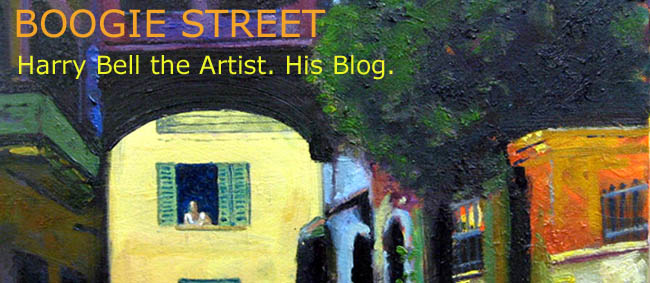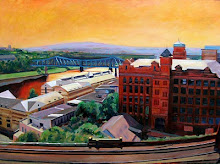In the Comments on New & Old, there's a point been raised that I think is worthy of further discussion here.
Anna said... "I liked the old sky rather a lot, in fact I liked the literal record of that scene. You're interpreting it with your current eye. Is this a pity? Both are good work but the first is true."
But how true is it? I originally painted the picture in my studio at home, using photographs I'd taken on a weekend's visit to Catterline. In 2005, I'd been invited to put on a solo show in the Creel Inn at Catterline and it seemed only fair to include a painting of the Inn. But as the sky in the photograph I had was fairly nondescript, I used another photograph taken on the same day, but just over the hill from the Inn.
Maybe it was the knowledge that the two didn't actually marry up that preyed on my feeling for the picture, but I never accepted that it worked properly. Last year, possibly in a fit of frustration, I simply painted out the sky and put it to one side.
There's a wildness to the landscape round Catterline that I think is conveyed better in the new version, so it's interesting that ian gordon should say:
"I think anna's comment raises an interesting point; the artist's dilemma: When is something truly finished?But I find the latest version "truer", in as much as I get the sensation of being there. I think the sense of depth is much stronger now than before."
For me, despite my being removed from the scene by many miles and quite some time, I believe I've captured a "truer" picture of how I felt and what impression the area had on me. But truth in this sense is, of course, completely subjective. The photograph from which I worked is no nearer the truth than either of the paintings, but I think I've come closer to a personal truth than previously. And in the end, personal truth is all I can reasonably strive for.
Wednesday, 6 August 2008
Subscribe to:
Post Comments (Atom)












8 comments:
Of course the question of when a painting is finished is entirely in the wish of the artist, but it can effect loss. What I was trying to get at, I suppose, was truth in an entirely temporal sense - that we see what you saw and intended at the moment of painting; the subject and its source in this context being secondary. Much later you would make it something quite other. Why would you not leave it to stand and paint a new version? If Monet had overpainted each of his haystacks with the later version we would have been the poorer. (That's slightly spurious as it was an intended series - but the thought is there) Ach! I think a short treatise on The Psychology and Artistic Ethics of Tweaking would be illuminating.
Many people (not Anna above), have this notion that something like a Constable is more "accurate" or "true to life", than a Monet.. It's not. All the sensation of movement, light, and changing conditions, is in the Monet. He brings the outside, inside. Whereas Constable allows us to sit comfortable and peruse the details from our armchair. (Great though he is).
Another example would be how Turner developed towards conveying "the truth". Whereas early on he would paint us a picture of a storm, later he would place us at the centre of that storm, in all its gut wrenching glory (whether we liked it or not). I argue the second image is far closer the truth.
The same with conventional perspective. We don't actually see the world like this. Rather we wonder about taking in quick glances at what is around us, from different sides and angles, letting our brain pick and choose what we need.
Similarly, this drawing
does not begin to convey "the truth" about crying. But this painting does. Before your very eyes she is moving, trying to catch her breath, whilst the shapes and colours even convey the distressing sound. It's the Truth.
Harry, Anna, Ian, I'm really enjoying this discussion. There are many truths, I think. Or perhaps many facets/aspects of truth. Is it possible that when a viewer connects with one painting and not another, there is something true for them about the first painting but not the second?
Doctor pam,
It's true that Truth comes from a person's perspective. Two people will give different accounts of something they see happen. Neither are lying, even though the accounts don't match.
Ian, you illustrate your point very well, that truth in painting has little to do with realism but an ability to convey emotion and presence.
The time thing I mentioned is difficult and probably artistically nitpicking, but it's nibbling me now. If Harry wants to change his painting the day after he first thinks it's finished, that's OK, he's still within the process of seeing. But in six months or a year, or 10 years? Then he will be seeing something different because his style and vision is changed. Have we lost something true if he changes it? When eventually Harry's gone to his maker and we want to see 'the early work' that tells us something about him as a painter - like the Turners you cite - if he's mucked it about it won't be 'true' to the evolutionary process or even present.
But there again, most of the greats overpainted - and we will never know at which stage they did so. So this is probably a lot of old tosh.
That particular point is a good one.
Although Van Gogh became a genius in Arles, (and in my opinion painted more Truthfully), i would have hated not to have access to the Potato Eaters.
Anna, I think this might hinge on the concept of "finished". If an artist considers an image to be finished at whatever date, then there it is, and I agree with you. However, if an artist leaves a piece unfinished, regardless of whether the finishing of it would have been different at different points in time, I think the decision to finish-now, finish-later or abandon-all-hope has to be entirely up to the artist.
Does "the process of seeing" have a sell-by date, or is there something about that process which this non-artist is entirely failing to grasp? I wonder if the sadness associated with the loss of an earlier image might be like noticing that a teenager has lost his baby curls and gained a tattoo or three? They may be really cool tattoos, but those curls were so adorable! Thank goodness for photos, in both cases, I guess....
Okay, my last thoughts:
I think you are both talking about the process of when a painting is finished, and I have to agree that changing something after the event is maybe questionable. (Was this actually changed after the event? Or was he still working it out in his mind?)
My point was all about the interpretation of that scene in the first place. This is where I say Monet is actually FAR more truthful than Constable, and Picasso FAR more truthful in terms of perception and observation than any of the Renaissance guys.
Bye all. Good chat!
Post a Comment